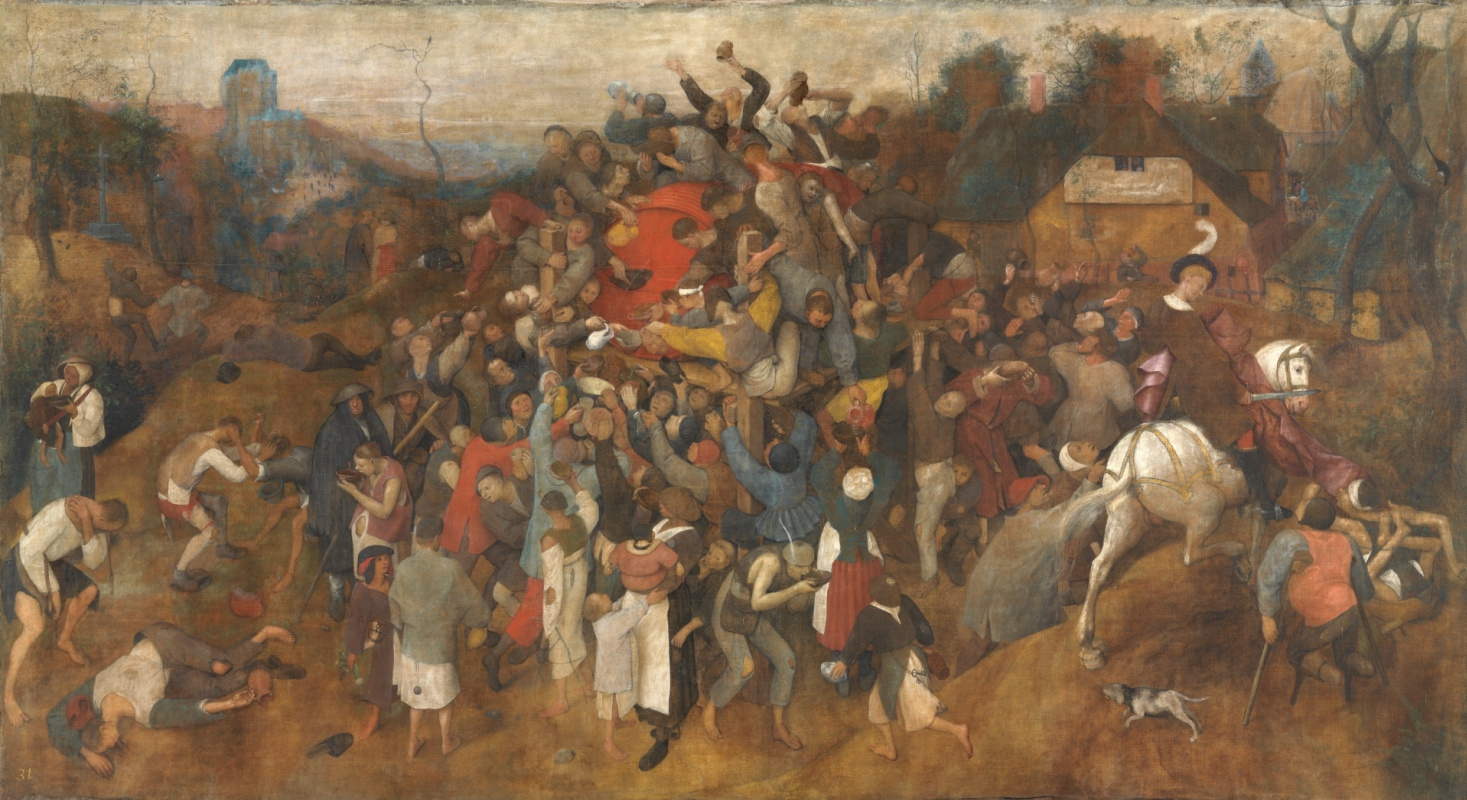The Museo del Prado in Madrid presented The Triumph of Death by Pieter Bruegel the Elder (1562−1563) after a thorough restoration. The painting depicts a theme frequently used by medieval authors of the North: the play of the Death. After a one-year set-up, the artwork has taken its place of honour next to another Bruegel treasure, The Wine of Saint Martin’s Day, acquired by the museum in 2011.

This painting once belonged to Queen Isabel Farnesio; in 1745, it has been placed at the La Granja Palace. A moralising work, showing the triumph of Death over those mundane things people are often attached to. A large army of deathly skeletons who raze people on the Earth; all the ground is filled with destruction and overwhelming horror aroused by inevitable end of life. In the foreground, we see Death on his rawboned reddish horse leading a terrific army. All those people are forced to an enormous coffin, leaving no hope for salvation.
Triumph of death
1563, 117×162 cm
The moralising sense of the scene is the result of Hieronymus Bosch's influence. The entire painting is cast in a reddish-brown tone adding some hellish motif for the subject.
According to Alejandro Vergara, responsible for painting conservation, this painting is "one of works that are backbone of the Museum collection". The artwork restoration was carried out by María Antonia López de Asiain (the paint layer) and José de la Fuente (the support). The work of their respective teams revealed the true colours of the painting, recovered its composition and the support stiffness. Thanks to their effort, we can see the special technique of brush strokes made with strong movements to achieve transparent background and sharp close-ups.
According to Alejandro Vergara, responsible for painting conservation, this painting is "one of works that are backbone of the Museum collection". The artwork restoration was carried out by María Antonia López de Asiain (the paint layer) and José de la Fuente (the support). The work of their respective teams revealed the true colours of the painting, recovered its composition and the support stiffness. Thanks to their effort, we can see the special technique of brush strokes made with strong movements to achieve transparent background and sharp close-ups.
Pieter Bruegel the Elder. The Triumph of Death. Detail.
The Bruegel’s work is originally painted on a support of four horizontal oak panels. After some time, they were planed to reduce their thickness (6 to 8 mm) and reinforced with a cradle to prevent any movement of the wood. However, sanding caused partial paint loss above the internal parts of the panels. The panels got closer and the joints were covered with gesso and repainted, which concealed part of the original picture.
Moreover, the upper panel was damaged and covered with multiple cracks. The present restoration has removed the cradle to free up the natural movement of the wood. The cracks and the panels have been realigned to form a level surface, and the upper panel has been repositioned to ensure that it lies flat. The support recovery involved attaching flat, stainless steel springs with brass buttons in nylon screws to allow for any movement in 360º of traction, dilation and contraction within the plane.
Moreover, the upper panel was damaged and covered with multiple cracks. The present restoration has removed the cradle to free up the natural movement of the wood. The cracks and the panels have been realigned to form a level surface, and the upper panel has been repositioned to ensure that it lies flat. The support recovery involved attaching flat, stainless steel springs with brass buttons in nylon screws to allow for any movement in 360º of traction, dilation and contraction within the plane.
The Wine of Saint Martin's Day
1657, 148×270.5 cm
As María Antonia López de Asiain put it, the painting has undergone several previous restorations, which actually masked the original paint. The present team of restorers used infrared reflectography and studied the copies of the painting made by Peter Breugel’s sons to rebuild its original state and reveal the small lost elements invented in previous treatments with erroneous reconstruction.
Thus, the painting needed thorough cleaning. The added complication was that the thin layer of the original pigment was very subtle in contrast to the thickness and stiffness of the areas later covered with paint. Removing the overall repainting has succeeded in removing the warm toned veil added in earlier restorations, thus revealing previously concealed details of the original painting. All the painting was covered with a layer of ochre colour, so the restoration aimed to remove it. Consequently, the picture has changed its tonality so that it becomes possible to appreciate its intense blue and red tones. After all the repainting areas were cleared, the composition acquired its previous complexity and depth of the landscape .
Thus, the painting needed thorough cleaning. The added complication was that the thin layer of the original pigment was very subtle in contrast to the thickness and stiffness of the areas later covered with paint. Removing the overall repainting has succeeded in removing the warm toned veil added in earlier restorations, thus revealing previously concealed details of the original painting. All the painting was covered with a layer of ochre colour, so the restoration aimed to remove it. Consequently, the picture has changed its tonality so that it becomes possible to appreciate its intense blue and red tones. After all the repainting areas were cleared, the composition acquired its previous complexity and depth of the landscape .
The triumph of death
1610-th
, 48×70 cm
Arthive: watch us on Instagram
Following the official web site of the Museo del Prado, Turkey Telegraph and Artdaily
Cover photo: The Triumph of Death by Pieter Bruegel the Elder, Museo Nacional del Prado. Source: HitchHikersHandbook.com
Following the official web site of the Museo del Prado, Turkey Telegraph and Artdaily
Cover photo: The Triumph of Death by Pieter Bruegel the Elder, Museo Nacional del Prado. Source: HitchHikersHandbook.com






















